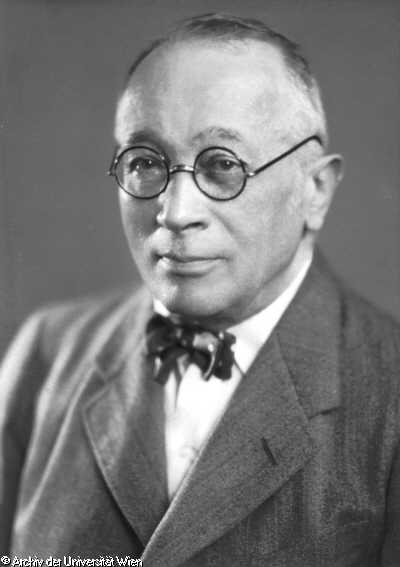Robert Kienböck
| Born: |
01-11-1871 |
| Faculty: |
Medical School | Medical University Vienna |
| Category: |
Expelled teacher |
Robert KIENBÖCK (born on January 11th, 1871 in Vienna, died on September 8th, 1953 in Vienna) was an extraordinary professor for medical radiology at the Medical School of the University of Vienna.
He was persecuted in times of Nazism because of his political orientation lost his position and was thrown out of the university on April 22nd, 1938.
Kienböck attended the Schottengymnasium secondary school in Vienna from 1881 to 1889 and then studied medicine at the University of Vienna as well as at the University of Heidelberg in the winter semester of 1893/94.
[1] In 1895 he obtained his medical doctorate, after which he went for study trips to Paris and London in 1896/97,
[2] where he applied himself to neurological, dermatological and bacteriological studies.
[3] After his return to Vienna he worked at the pathological-anatomical institute under Anton Weichselbaum and then at the 3rd medical clinic at the general hospital under Leopold Schrötter von Kristelli and as an assistant doctor at the Kaiser-Franz-Josef clinic. Still under Schrötter, in 1897, he turned to the practical application of X-rays, which had been discovered by Wilhelm Konrad Röntgen only two years earlier. During this time, he founded his own private radiology institute at the Fürth sanatorium in 1899 and habilitated for radiology together with Leopold Freund and Guido Holzknecht. Thus a new specialty subject at the medical faculty was born. Kienböck furthermore founded the first independent radiology department in Austria at the general outpatient clinic as well as publishing the notable book “Radiotherapie” in 1907.
[4] A fall off his horse in 1910 was to be an incisive event for Kienböck, who suffered a skull fracture and leading to severe depression and reclusiveness.
[5] Meanwhile, he received an associate professorship at the University of Vienna in 1915 and was made and received a permanent teaching position in 1926.
[6]
The National Socialists put Kienböck on leave “from his teaching position until his heritage is clarified” in April 1938.
[7] In a political assessment the Gauleitung (administration of the Gau) described him as “descended from Jews, baptized and with a Christian-Social attitude”.
[8] In the Reich doctors’ registry his “descent” is recorded as “German-blooded”, however.
[9] The mentioned Christian-Social attitude can presumably be traced back to Kienböck’s brother,
[10] the former Christian-Social finance minister (1922-24 and 1926-29) Viktor Kienböck. He had been president of the Austrian national bank since 1932 and was removed from all offices in 1938.
[11] Kienböck himself was now “struck from the Viennese university’s list of professors”.
[12] With the help of the Reich doctors’ registry his further career during National Socialism can be reconstructed to a certain degree: He was registered as an X-ray specialist in Vienna in 1939, while retiring from the radiology department of the general outpatient clinic at the end of 1940. Apparently, he stopped practicing medicine in December 1942.
[13]
Because of his advanced age, Kienböck did not return to work after the end of the war.
In his work he especially focused on radiological diagnosis of bone diseases, for which he created new designations - some of which are still in use today.
[14] He is the namesake of “Kienböck’s disease” (aseptic osteonecrosis of the lunate bone in the wrist),
[15] “Kienböck’s unit” as well as “Kienböck’s bone therapy”.
[16]
From 1934 until 1942 eight volumes of his - unfinished - work on radiological diagnosis of bone and joint diseases were published. Other significant achievements attributable to Kienböck are in the field of therapeutic applications of X-rays.
[17] In this regard, in particular his method to dosage X-ray intensity (“quantimeter”) should be noted.
[18] In his more than 100 papers and lectures he also addressed the radiological treatment of skin diseases as well as diseases of the inner organs, especially cancer.
[19]
Kienböck was the long-standing chairman of the Wiener Röntgengesellschaft (Viennese X-Ray Society) and acted as the president of the Viennese radiological congress in 1936.
[20] In 1935 he became the first president of the Österreichische Gesellschaft für Röntgenkunde (Austrian Society for X-Ray Science), which was founded in December 1934. His presidency ended in 1938, but after the war he was made honorary president of the organization, which had in the meantime changed its name to “Österreichische Röntgengesellschaft”.
[21] He also was a member of the Doctors’ Society in Vienna.
[22]
Lit.: Federal Archives Berlin Reichsärzteregister; Austrian State Archive/AdR, GA Kienböck; Austrian State Archive/AVA, PA Kienböck; Archive of the University of Vienna /PA MED 728; CZEIKE Vol. 3 1994; FREUDIG/COLLATZ 1996; KILLY Vol. 5 1997; MERINSKY 1980, 122-123; MÜHLBERGER 1993, 24. Die Geschichte der "Österreichischen Röntgengesellschaft"; TEICHL 1951; UB MedUni Wien/van Swieten Blog; Whonamedit? A dictionary of medical eponyms.
[3] ÖStA/AVA, PA, k. k. nö. Statthalterei Zl. 1310, Curriculum vitae, o. D.
[7] UA, RA GZ 677 ex 1937/38, O.-Nr. 48, MED Dekanat an Kienböck, 11. 4. 1938 (Abschrift).
[8] ÖStA/AdR, GA, Bericht der Gauleitung Wien, 17. 8. 1938.
[9] BArch, Reichsärzteregister.
[10] ÖStA/AdR, GA, Bericht der Gauleitung Wien, 17. 8. 1938.
[12] ÖStA/AdR, GA, Bericht der Gauleitung Wien, 17. 8. 1938.
[13] BArch, Reichsärzteregister. So findet sich in der Zeile "Ohne ärztl. [im Original unterstrichen, Anm.] Tätigkeit" der Eintrag "Dez. 42".
Andreas Huber (translated by Thomas Rennert)
